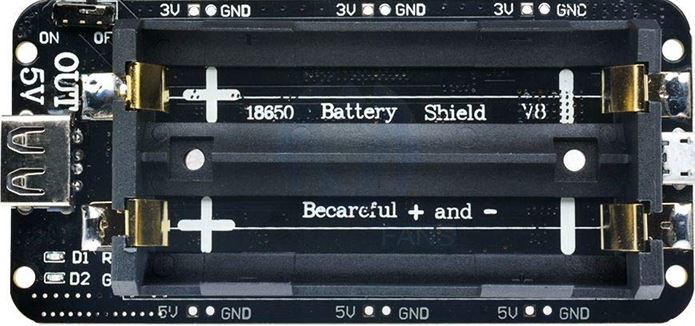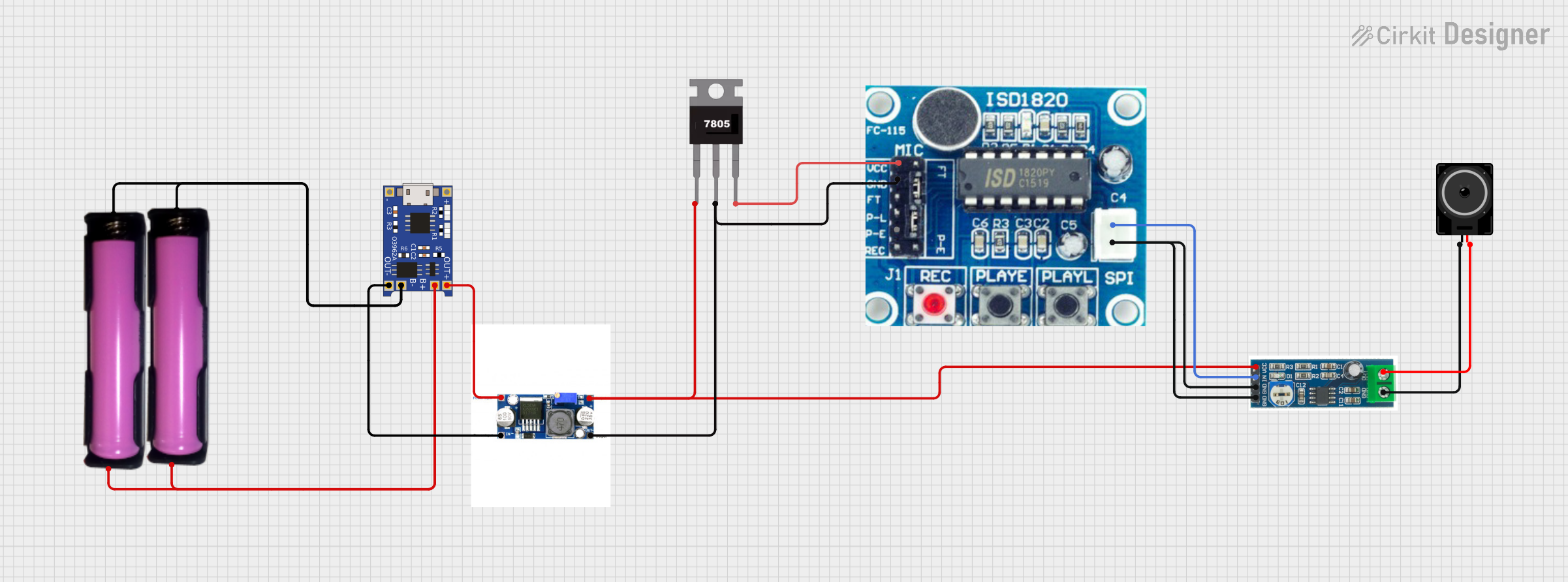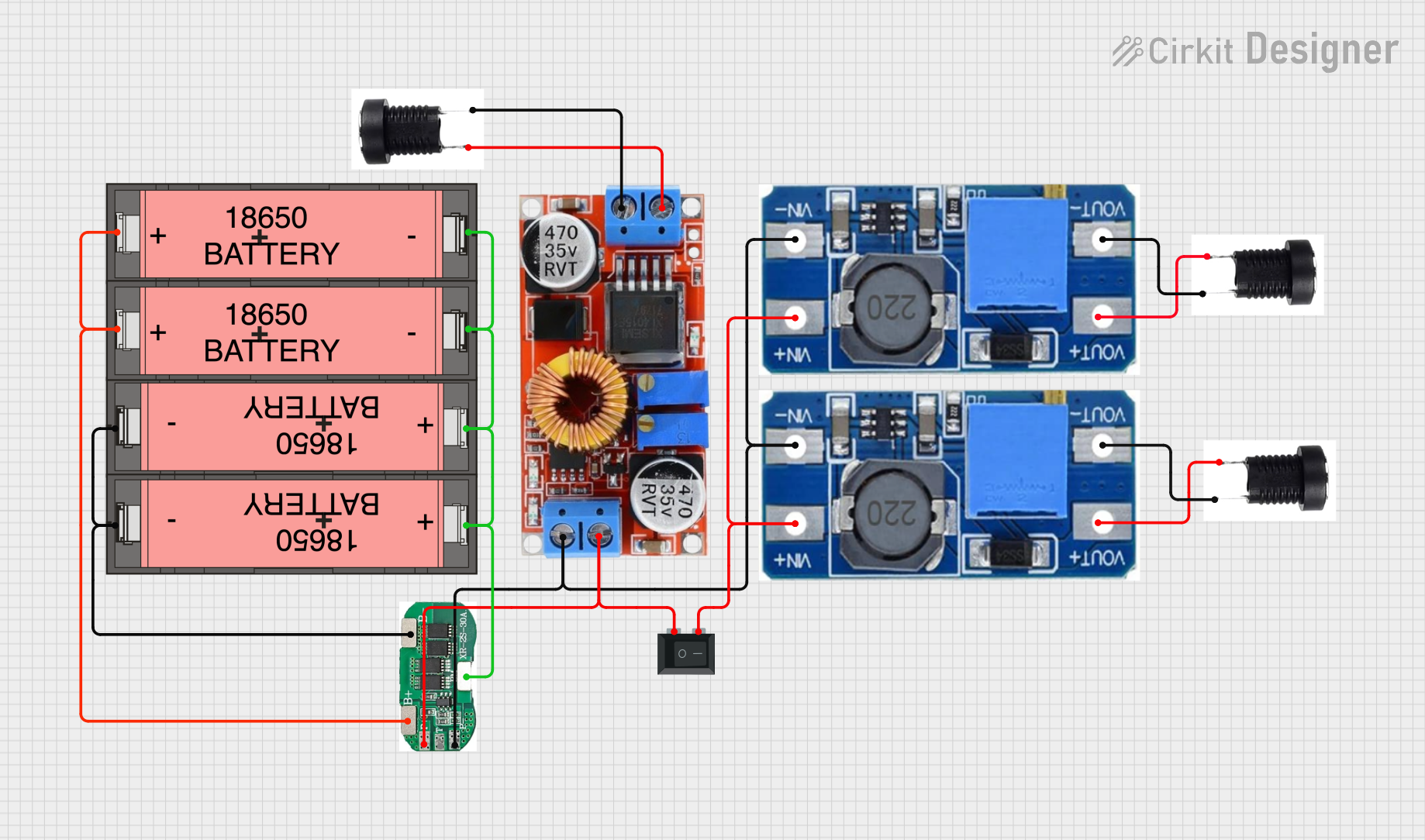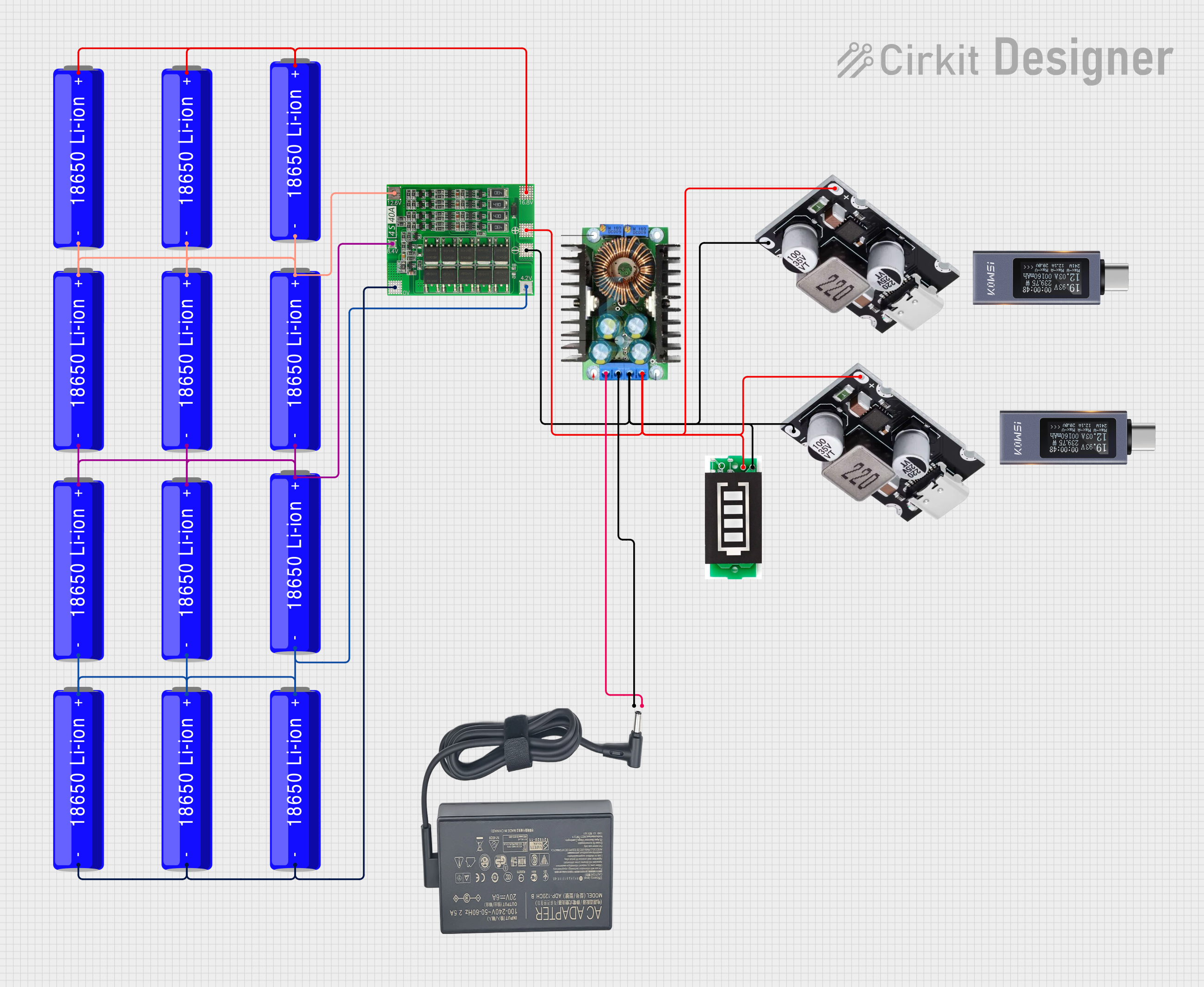
How to Use 18650 Battery Shield V8: Examples, Pinouts, and Specs

 Design with 18650 Battery Shield V8 in Cirkit Designer
Design with 18650 Battery Shield V8 in Cirkit DesignerIntroduction
The 18650 Battery Shield V8, manufactured by DIYMORE, is a versatile battery management board designed to hold and protect 18650 lithium-ion batteries. It provides essential features such as overcharge protection, over-discharge protection, and short circuit protection, ensuring the safety and longevity of the battery. Additionally, the shield includes a built-in boost converter to provide a stable 5V output, making it ideal for powering various electronic projects.
Explore Projects Built with 18650 Battery Shield V8

 Open Project in Cirkit Designer
Open Project in Cirkit Designer
 Open Project in Cirkit Designer
Open Project in Cirkit Designer
 Open Project in Cirkit Designer
Open Project in Cirkit Designer
 Open Project in Cirkit Designer
Open Project in Cirkit DesignerExplore Projects Built with 18650 Battery Shield V8

 Open Project in Cirkit Designer
Open Project in Cirkit Designer
 Open Project in Cirkit Designer
Open Project in Cirkit Designer
 Open Project in Cirkit Designer
Open Project in Cirkit Designer
 Open Project in Cirkit Designer
Open Project in Cirkit DesignerCommon Applications and Use Cases
- Power supply for Arduino, Raspberry Pi, and other microcontroller projects
- Portable power banks for USB-powered devices
- DIY IoT devices and wearable electronics
- Robotics and small motorized systems
- Emergency backup power for small electronics
Technical Specifications
The following table outlines the key technical details of the 18650 Battery Shield V8:
| Parameter | Specification |
|---|---|
| Input Voltage | 3.0V - 4.2V (18650 battery voltage) |
| Output Voltage | 5V (via USB port) |
| Output Current (Max) | 1A |
| Charging Input Voltage | 5V (via micro-USB port) |
| Charging Current | 1A |
| Protection Features | Overcharge, over-discharge, short circuit |
| Battery Type Supported | 18650 lithium-ion battery |
| Dimensions | 60mm x 24mm x 18mm |
Pin Configuration and Descriptions
The 18650 Battery Shield V8 includes several pins and connectors for easy integration into projects. The table below describes each pin and connector:
| Pin/Connector | Description |
|---|---|
| Micro-USB Port | Used for charging the 18650 battery. Accepts 5V input. |
| USB-A Port | Provides a 5V output for powering external devices. |
| BAT+ | Positive terminal of the 18650 battery. |
| BAT- | Negative terminal of the 18650 battery. |
| OUT+ | Positive output terminal for external connections (5V). |
| OUT- | Negative output terminal for external connections (GND). |
| Indicator LEDs | Displays charging status and power output status. |
Usage Instructions
How to Use the 18650 Battery Shield V8 in a Circuit
- Insert the Battery: Place a single 18650 lithium-ion battery into the holder, ensuring correct polarity (BAT+ and BAT-).
- Charge the Battery: Connect a 5V power source to the micro-USB port to charge the battery. The charging indicator LED will light up during charging and turn off when fully charged.
- Connect to a Load: Use the USB-A port or the OUT+ and OUT- pins to power your device. The shield will provide a stable 5V output.
- Monitor the LEDs: Use the indicator LEDs to check the charging and power status.
Important Considerations and Best Practices
- Battery Compatibility: Only use 18650 lithium-ion batteries. Ensure the battery is not damaged or over-discharged before use.
- Heat Management: Avoid using the shield in high-temperature environments, as excessive heat can damage the battery or the shield.
- Current Limitations: Do not exceed the maximum output current of 1A to prevent damage to the shield or connected devices.
- Polarity: Always ensure correct polarity when inserting the battery to avoid short circuits or damage.
Example: Using the Shield with an Arduino UNO
The 18650 Battery Shield V8 can be used to power an Arduino UNO via its USB-A port. Below is an example of connecting the shield to an Arduino UNO and running a simple LED blink program:
Circuit Connection
- Insert a fully charged 18650 battery into the shield.
- Connect the USB-A port of the shield to the Arduino UNO's USB port using a USB cable.
Arduino Code
// Simple LED Blink Program for Arduino UNO
// This program blinks the built-in LED on pin 13
void setup() {
pinMode(13, OUTPUT); // Set pin 13 as an output pin
}
void loop() {
digitalWrite(13, HIGH); // Turn the LED on
delay(1000); // Wait for 1 second
digitalWrite(13, LOW); // Turn the LED off
delay(1000); // Wait for 1 second
}
Troubleshooting and FAQs
Common Issues and Solutions
Battery Not Charging
- Cause: The battery may be damaged or inserted incorrectly.
- Solution: Check the battery polarity and ensure it is a compatible 18650 lithium-ion battery. Replace the battery if necessary.
No Output Voltage
- Cause: The battery may be discharged or the shield may be overloaded.
- Solution: Recharge the battery using the micro-USB port. Ensure the connected load does not exceed 1A.
Shield Overheating
- Cause: Excessive current draw or high ambient temperature.
- Solution: Reduce the load current and ensure proper ventilation around the shield.
LED Indicators Not Working
- Cause: Faulty LEDs or insufficient power supply.
- Solution: Verify the battery charge level and ensure the shield is functioning correctly.
FAQs
Q: Can I use multiple 18650 batteries with this shield?
A: No, the 18650 Battery Shield V8 is designed to hold and manage a single 18650 battery.
Q: Is the shield compatible with other battery types?
A: No, this shield is specifically designed for 18650 lithium-ion batteries. Using other battery types may damage the shield or cause unsafe conditions.
Q: Can I charge the battery while powering a device?
A: Yes, the shield supports simultaneous charging and discharging, but ensure the total current does not exceed 1A.
Q: What happens if I connect a load that requires more than 1A?
A: The shield may overheat or shut down to protect itself. Always ensure the load current is within the specified limit.